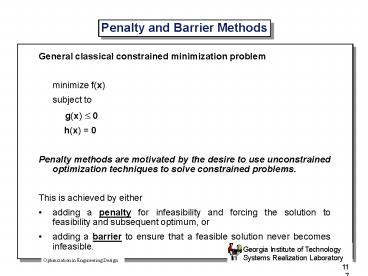Penalty and Barrier Methods - PowerPoint PPT Presentation
1 / 7
Title:
Penalty and Barrier Methods
Description:
Penalty methods are motivated by the desire to use unconstrained optimization ... adding a penalty for infeasibility and forcing the solution to feasibility and ... – PowerPoint PPT presentation
Number of Views:202
Avg rating:3.0/5.0
Title: Penalty and Barrier Methods
1
Penalty and Barrier Methods
- General classical constrained minimization
problem - minimize f(x)
- subject to
- g(x) ? 0
- h(x) 0
- Penalty methods are motivated by the desire to
use unconstrained optimization techniques to
solve constrained problems. - This is achieved by either
- adding a penalty for infeasibility and forcing
the solution to feasibility and subsequent
optimum, or - adding a barrier to ensure that a feasible
solution never becomes infeasible.
2
Penalty Methods
Penalty methods use a mathematical function that
will increase the objective for any given
constrained violation.
General transformation of constrained problem
into an unconstrained problem
min T(
x
) f(
x
) r
P(
x
)
k
where
f(
x
) is the objective function of the constrained
problem
r
is a scalar denoted as the penalty or
controlling parameter
k
P(
x
) is a function which imposes penalities for
infeasibility (note that P(
x
)
is
controlled by r
)
k
T(
x
) is the (pseudo) transformed objective
- Two approaches exist in the choice of
transformation algorithms - 1) Sequential penalty transformations
- 2) Exact penalty transformations
3
Sequential Penalty Transformations
- Sequential Penalty Transformations are the oldest
penalty methods. - Also known as Sequential Unconstrained
Minimization Techniques (SUMT) based upon the
work of Fiacco and McCormick, 1968.
4
Two Classes of Sequential Methods
- Two major classes exist in sequential methods
- 1) First class uses a sequence of infeasible
points and feasibility is obtained only at the
optimum. These are referred to as penalty
function or exterior-point penalty function
methods. - 2) Second class is characterized by the property
of preserving feasibility at all times. These
are referred to as barrier function methods or
interior-point penalty function methods.
General barrier function transformation
T(x) y(x) r
B(
x
)
k
where B(
x
) is a barrier
function and r
the penalty parameter which is supposed to go to
k
zero when k approaches infinity.
Typical Barrier functions are the inverse or
logarithmic, that is
m
m
å
-1
B(
x
)
g
(
x
)
or B(
x
)
lng
(
x
)
å
i
i
i1
i1
5
What to Choose?
- Some prefer barrier methods because even if they
do not converge, you will still have a feasible
solution. - Others prefer penalty function methods because
- You are less likely to be stuck in a feasible
pocket with a local minimum. - Penalty methods are more robust because in
practice you may often have an infeasible
starting point. - However, penalty functions typically require more
function evaluations. - Choice becomes simple if you have equality
constraints. (Why?)
6
Exact Penalty Methods
- Theoretically, an infinite sequence of penalty
problems should be solved for the sequential
penalty function approach, because the effect of
the penalty has to be more strongly amplified by
the penalty parameter during the iterations. - Exact transformation methods avoid this long
sequence by constructing penalty functions that
are exact in the sense that the solution of the
penalty problem yields the exact solution to the
original problem for a finite value of the
penalty parameter. - However, it can be shown that such exact
functions are not differentiable. - Exact methods are newer and less well-established
as sequential methods.
7
Closing Remarks
- Typically, you will encounter sequential
approaches. - Various penalty functions P(x) exist in the
literature. - Various approaches to selecting the penalty
parameter sequence exist. Simplest is to keep it
constant during all iterations. - Always ensure that penalty does not dominate the
objective function during initial iterations of
exterior point method.































